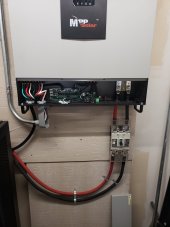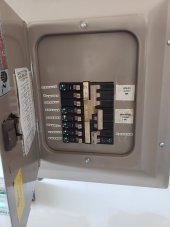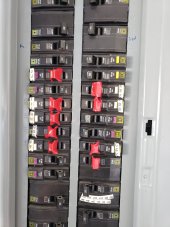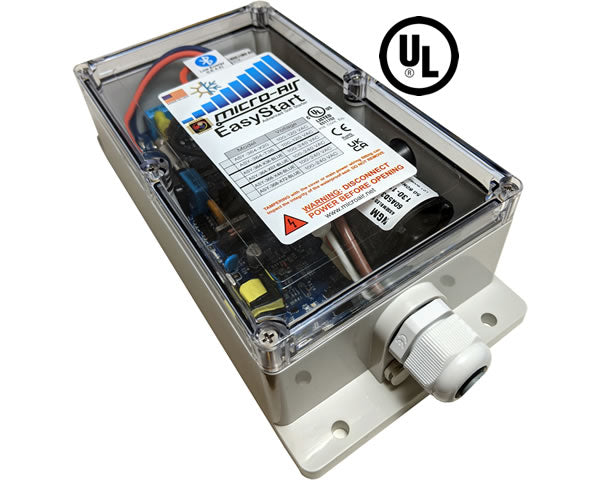Ok, building my storage system bit by bit. I can run most of my house off battery, but I am having a voltage drop issue.
My apologies in advance for the long post. I want to provide as much info as possible.
Here's the build. No PV connected yet. I use AC input on the inverter to charge the batteries for now.
1 x MPP Solar LV6048
4 x EG4-LL 48V batteries with Signature Solar 6 space rack.
1 x 200A T Class Fuse
1 x Victron smart shunt.
1 x Eaton CH10Gen5050SN switched neutral transfer switch used as sub panel. This was a Eaton CH10Gen5030SN but I switched the 30 amp input breaker to a 50 amp input breaker as I assumed that was the issue with the voltage sag. It was not.
1 x 200amp DC cicuit breaker to allow batteries to be disconnected to service the inverter.
The 8 + 1 double pole breaker marked in red on the main load center have been moved to the transfer switch. The double pole is for the heat pump which is a 25 amp breaker. With the exception of the heat pump, I have kept all other high load circuits out. Range, Dryer, Dishwasher, Resistive Coils for emergency heat etc
Inverter output is wired to the transfer switch with THHN 6awg wire. The run is less than 25 feet as I ordered 25 feet and cut some off after running the wire end to end. I cut off at most 2 feet.
For the batteries in the rack I did not run Signature Solar's provide cabling. I used 1/0 gauge wire from the battery terminals to the rack's bus bars.
The bus bars are connected to the inverter with 4/0 gauge wire. 4/0 from bus bars to T Class Fuse & Victron Smart Shunt and 4/0 from these to the inverter.
When running off utility power, all the circuits operate without issue from the top right 50 amp utility breaker in the transfer switch.
When I switch to battery power, Things still run, but with issues when the heat pump kicks on. When it does, even though my server rack has it's own ups, it kicks my main media server off line and you can hear the ups click on and off. Battery to "Line" battery to Line. I can watch the lcd screen on the ups's roaming from the usual 120v input to as low as 110v back to 117v etc. The server rack for my media sever has a second ups that has all the network equipment, router etc connected to it and the internet stays up. Note that both these ups's in the server rack are connect to 1 dedicated 20 amp breaker at the transfer switch.
I have another UPS thats connected to my entertainment center and it does the same voltage roaming, just not as badly, and I do not lose the tv, receiver, media player or switches connected to it.
After the heat pump has been on a couple minutes everything settles. I can turn the media server back on and the ups then handles the voltage fluctuations, but still clicks back and forth from the ups battery.
My question is, if all these circuits run no problem on a 50 amp utility power circuit, why would I be having issues with a 50 amp (generator) battery circuit?
Any in put is greatly appreciated.
My apologies in advance for the long post. I want to provide as much info as possible.
Here's the build. No PV connected yet. I use AC input on the inverter to charge the batteries for now.
1 x MPP Solar LV6048
4 x EG4-LL 48V batteries with Signature Solar 6 space rack.
1 x 200A T Class Fuse
1 x Victron smart shunt.
1 x Eaton CH10Gen5050SN switched neutral transfer switch used as sub panel. This was a Eaton CH10Gen5030SN but I switched the 30 amp input breaker to a 50 amp input breaker as I assumed that was the issue with the voltage sag. It was not.
1 x 200amp DC cicuit breaker to allow batteries to be disconnected to service the inverter.
The 8 + 1 double pole breaker marked in red on the main load center have been moved to the transfer switch. The double pole is for the heat pump which is a 25 amp breaker. With the exception of the heat pump, I have kept all other high load circuits out. Range, Dryer, Dishwasher, Resistive Coils for emergency heat etc
Inverter output is wired to the transfer switch with THHN 6awg wire. The run is less than 25 feet as I ordered 25 feet and cut some off after running the wire end to end. I cut off at most 2 feet.
For the batteries in the rack I did not run Signature Solar's provide cabling. I used 1/0 gauge wire from the battery terminals to the rack's bus bars.
The bus bars are connected to the inverter with 4/0 gauge wire. 4/0 from bus bars to T Class Fuse & Victron Smart Shunt and 4/0 from these to the inverter.
When running off utility power, all the circuits operate without issue from the top right 50 amp utility breaker in the transfer switch.
When I switch to battery power, Things still run, but with issues when the heat pump kicks on. When it does, even though my server rack has it's own ups, it kicks my main media server off line and you can hear the ups click on and off. Battery to "Line" battery to Line. I can watch the lcd screen on the ups's roaming from the usual 120v input to as low as 110v back to 117v etc. The server rack for my media sever has a second ups that has all the network equipment, router etc connected to it and the internet stays up. Note that both these ups's in the server rack are connect to 1 dedicated 20 amp breaker at the transfer switch.
I have another UPS thats connected to my entertainment center and it does the same voltage roaming, just not as badly, and I do not lose the tv, receiver, media player or switches connected to it.
After the heat pump has been on a couple minutes everything settles. I can turn the media server back on and the ups then handles the voltage fluctuations, but still clicks back and forth from the ups battery.
My question is, if all these circuits run no problem on a 50 amp utility power circuit, why would I be having issues with a 50 amp (generator) battery circuit?
Any in put is greatly appreciated.







